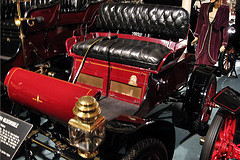Henry Ford is the man commonly given credit for transforming the automobile from a rich man’s toy to every man’s transportation.It was another Michigan resident, however, who set the stage for Ford’s revolution. Before Ransom E. Olds, the few cars that were being assembled were fabricated individually in machine shops and sold on a catch-as-catch-can basis to those few rich enough to afford the high asking prices. Olds was the man who orchestrated the innovation from the shop to the assembly line, making the automobile reasonably priced to a far larger audience, thus setting the stage for Henry’s Model T.

flic.kr/p/59cirV
Inveterate tinkerer
The son of a machinist, Olds studied accounting at a Lansing, Michigan, business college, but he always considers more at home in his father’s shop. With his schooling over, he joined the business, which operated in the thrilling world of repairing farm machinery. An inveterate tinkerer, Olds had dreams far beyond fixing plows.
In the late 1880s, several men from around the world were coming to the same assumption: Read more . . .
 The irony of the story is that these two luxury car powerplants, among the most remarkable the world has ever produced, were spawned during the world’s most far-reaching and destructive economic collapse.
The irony of the story is that these two luxury car powerplants, among the most remarkable the world has ever produced, were spawned during the world’s most far-reaching and destructive economic collapse. The original Lincoln Continental, produced as a one-off by Bob Gregorie and his design staff for the personal use of Edsel Ford, was, with little argument, the best American auto design of the 1940’s. Mildly production-ized and sold as a series into the late Forties, it was a masterpiece. Ford Motor Company attempted to re-create the same magic some 15 years later with the Mark II, but to re-create magic is a tougher task than the first time.Though the Mark II lacked the essential rightness of the original’s proportions, still, it was a car to be reckoned with. By sheer presence, sheer mass, sheer price, it was a vehicle that epitomized 1950’s America.
The original Lincoln Continental, produced as a one-off by Bob Gregorie and his design staff for the personal use of Edsel Ford, was, with little argument, the best American auto design of the 1940’s. Mildly production-ized and sold as a series into the late Forties, it was a masterpiece. Ford Motor Company attempted to re-create the same magic some 15 years later with the Mark II, but to re-create magic is a tougher task than the first time.Though the Mark II lacked the essential rightness of the original’s proportions, still, it was a car to be reckoned with. By sheer presence, sheer mass, sheer price, it was a vehicle that epitomized 1950’s America. One of that very select number, though, is the topic of this profile. The LaSalle marque didn’t cease to exist because it faced year after year of deteriorating sales. No, the death of the LaSalle, strange as it sounds, was caused by its success.
One of that very select number, though, is the topic of this profile. The LaSalle marque didn’t cease to exist because it faced year after year of deteriorating sales. No, the death of the LaSalle, strange as it sounds, was caused by its success. Further, those roots are planted intensely in the soil of solidly Midwest Indiana, where they can be traced back to 1903, when Standard Wheel Company, a Terre Haute bicycle manufacturer, decided to enter the infant automobile industry with the introduction of the Overland Runabout, its first motor vehicle.
Further, those roots are planted intensely in the soil of solidly Midwest Indiana, where they can be traced back to 1903, when Standard Wheel Company, a Terre Haute bicycle manufacturer, decided to enter the infant automobile industry with the introduction of the Overland Runabout, its first motor vehicle.